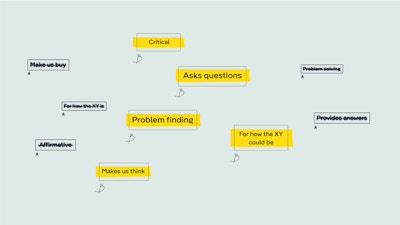Speculative design as a black swan countermeasure
What’s a black swan? In addition to being large waterbirds native to Australia, black swans are also a theory in economics and philosophy.

Illustration by Myriam Molitor
Black swan events are extremely rare, unpredictable phenomena that have severe economic and social effects. The theory goes that black swans are born of our collective and individual presumptions, biases, and day-to-day experiences. Our limited worldview blinds us to the fact that swans can be black — until we see it with our own eyes.
Are we doomed to always be caught off-guard by black swan events? Not quite: the power of speculation can expand our perspectives to potentially anticipate future black swans. A current example of a black swan is the COVID-19 pandemic. It could be argued that globally, our tunnel-vision focus on daily tasks and routines blinded us to the early warning signs of a major disruption.
In recent years, many institutions, enterprises, and even armies have hired science-fiction writers to create fictive scenarios. These scenarios speculate on potential disruptive phenomenon, with the goal of preparing people for an uncertain future. SciFuture, a US-based company, offers a 'sci-fi prototyping' service for their corporate clients including Visa, Ford, and PepsiCo.
From a development perspective, there are design methodologies like speculative design that could be leveraged to realize a visionary future. Speculative design approaches the world with a critical and exploratory mindset. It develops solutions discursively. Ultimately, speculative design is not meant to serve existing users; it’s intended to provoke and shape an audience.
Speculative design concept

In their primer, Speculative Everything, Anthony Dunne and Fiona Raby introduce their A/B manifesto. A represents what speculative design is not, whereas B represents what it is.
Nassim Nicholas Taleb, statistician and professor of the science of uncertainty, suggests focusing on the potential consequences of black swans rather than the probability that they will occur. For effective speculative design, we need to set aside our expectation of clear answers and be open to mingling with uncertainty. Practicing future-proof methods requires that we accept the fact that we can’t foresee the timing and form of an upcoming disruption. Instead, we can learn and speculate based on our experiences, then analyze and reiterate.
Future and crisis-proof businesses?
Being agile is another likely answer for future-proof businesses, and there’s a consensus on this. However, what are the necessary methods and mindsets? Agile Methodologies are proven to reduce development lifecycles, thus facilitating more iterations and prototyping compared to many of the traditional design methods. These practices foster adaptability and could be seen as an effective way of incorporating speculation throughout product development.
What are the potential positive outcomes of speculative design?
Hypothetically, let’s say that Airbnb was conceived through SD methods. Let’s take a look at the notional process:
- Economic recession (Critical black swan)
- People won’t be able to pay their rent (Problem-finding)
- How can they pay their rent? (Ask questions)
- Renting their rooms/apartments (How could…)
- How can we offer/propose the room-sharing to the market? (How could…)
- How to scale up the solution? (Makes us think…)
Primax, one of the leading petrol companies in Latin America, reached out to Designit for a future vision of their gas stations. During this project, we used speculative design practices to help the client think beyond their present reality. One of our future scenarios, La Paralisis, has been realized much faster than we initially hypothesized.
An overview of our process:
- Research
a. Interviewed the main stakeholders
b. Visited different gas stations
c. Observing and shadowing
d. Interviewed the managers, workers, clients
e. Conducted three co-creation groups with different age groups - Futures Workshop
a. Built four different future scenarios to help the client think outside their current, day-to-day limitations - Concept creation
a. Constructed a final concept that:
– Lays out a roadmap of initiatives that will allow them to accomplish future projects
– Creates a future vision for the company that goes beyond fuel
Through this project, we created services and spaces that would give Primax a presence outside of their current static gas stations. Designing how we envisioned their future gas stations and adapting this vision to their existing gas stations enabled them to evolve without discarding the stations entirely.
The concept around the speculated scenario, 'La Paralisis', was a curfew due to the high levels of pollution, which also necessitated a delivery system to get essentials to every household. This is a scenario that was speculated in another context. Yet we had faced with similar consequences during COVID-19 pandemics. We don’t need to estimate the time and the form of disruption to be prepared for similar scenarios.
Designing the future we want
Speculative design acts as a catalyst that stimulates thinking and questioning. This can spark actions and offer alternatives that impact not only today’s world, but our futures as well. By acknowledging this imaginative and radical approach, we can take the first steps toward designing the future we want.
With a playground to explore, experiment, and create, we can practice speculation not only to become future and crisis proof, but also to evolve the discipline of design. While it’s impossible to predict what’s coming up, we can learn to navigate the uncertainty.